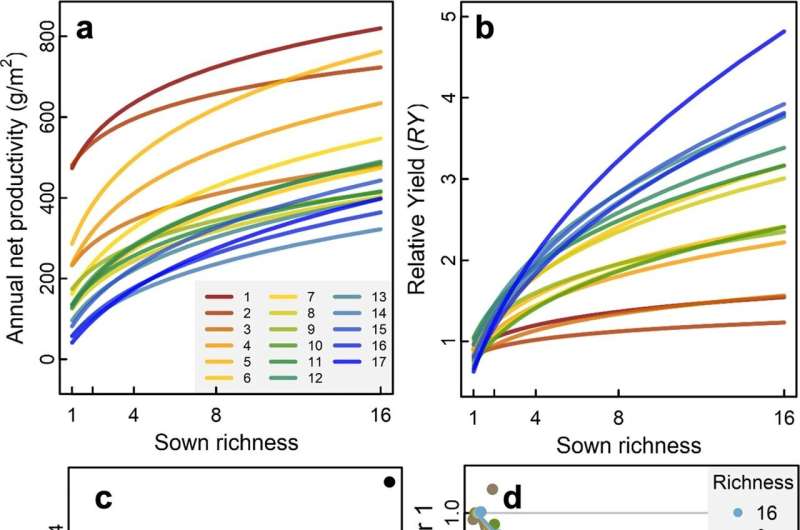This article has been reviewed according to Science X's editorial process and policies. Editors have highlighted the following attributes while ensuring the content's credibility:
fact-checked
peer-reviewed publication
proofread
Grassland ecosystems become more resilient with age, finds long-term biodiversity experiment

Recent experiments have shown that the loss of species from a plant community can reduce ecosystem functions and services such as productivity, carbon storage and soil health. With the loss of functioning the ecosystem may also become destabilized in its ability to maintain ecosystem functions and services in the long-term. However, assessing this is only possible if experiments can be maintained for a sufficient length of time.
In a new study published in Nature Communications, researchers from the University of Zurich and colleagues from Leipzig and Jena analyzed the stability of plant biomass production over two decades in one of the longest-running grassland biodiversity experiments in the world, the Jena Experiment in Germany. After more than a decade, plant species in more diverse experimental communities complemented each other in producing stable biomass at the community level.
At low plant diversity, by contrast, this "compensatory" effect was not realized and community biomass varied much more from year to year. During the first decade of the experiment species-rich communities had not yet stabilized because of large fluctuations in species populations.
This long-term research shows that biodiversity plays an increasingly important role in stabilizing ecosystem productivity over time as plant communities mature. Because ecosystem stability incurs resilience in the face of environmental perturbations, it follows that in a changing world, older, more diverse ecosystems should be particularly highly valued.
The first author, Dr. Cameron Wagg from the University of Zurich, says, "We now realize that the mechanisms by which diverse species communities maintain ecosystem functioning in the long-term are continually developing even two decades later. Such findings in this study highlight the importance of long-term research studies to fully appreciate the invaluable role of biodiversity for supporting ecosystem functions and services into the future."
The corresponding author, Prof. Dr. Bernhard Schmid from the University of Zurich, adds, "These novel results fit with other recent findings of our research group, suggesting that over time evolutionary processes in diverse plant communities select the most 'collaborative' plant genotypes among the different species, thus increasing division of labor, community productivity and ecosystem stability."
Prof. Dr. Nico Eisenhauer from iDiv and Leipzig University and speaker of the Jena Experiment, highlights, "Only such long-term studies can draw a realistic and comprehensive picture of the relevance of biodiversity for ecosystems and human well-being."
More information: Cameron Wagg et al, Biodiversity–stability relationships strengthen over time in a long-term grassland experiment, Nature Communications (2022). DOI: 10.1038/s41467-022-35189-2
Journal information: Nature Communications
Provided by iDiv





















